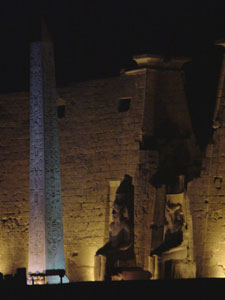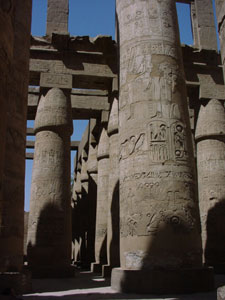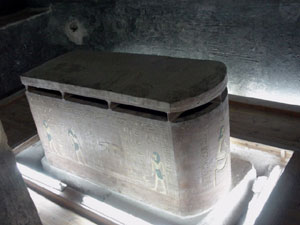![]()
| Egypt | Luxor | 2001.05.18 - 05.20 |
Kings and Queens
Luxor is the city where 50 or so tourists were killed in 1997 by militants rebelling against the Egyptian government. They thought they could damage the government most easily by eliminating vital tourist income that sustains the Egyptian economy. The impact to the economy has been detrimental to the government and everyone else in the country including themselves. Although the militants no longer target tourists, the number of visitors is still significantly low today, 4 years after the attack.
Several spectacular 3500 year old sites are in and around Luxor. In the middle of town is Luxor Temple built by Pharaoh Amenophis III. Several kilometers to the north is the Temple of Karnak, built and added onto over a 1500 year period starting with the Pharaohs of the New Kingdom (1580-1085 B.C.). Across the Nile River on the West Bank are the Valley of the Kings and Valley of the Queens, areas with ancient tombs once containing mummies and valuables for the Pharaoh's afterlife.
Downtown Luxor
Downtown Luxor on the East Bank of the Nile River is where the cheap accommodation and restaurants are. Tourists strolling around town are repeatedly accosted by locals trying to sell things: a hotel room, a horse-carriage ride, shirts, postcards, a restaurant menu, a felucca ride, etc. Peace is walking a block without someone yelling, "Hello! What's your name? Where are you from? Come into my store!" Sometimes when countering their insistence with "La, la, la. Emshee! (No. no, no. Go away!)", they aggressively accuse, "Why are you so rude?!" There's no way to win.
During our time in Luxor, Wes took antibiotics for his disorienting flu and occasionally walked around in a partial daze. We managed to view the perimeter of Luxor Temple at night (entrance is E£ 20, E£ 10 with student card), and learn about ancient Egyptian mummification at the Mummification Museum (entrance is E£ 20, E£ 10 with student card). Because the mummification ritual and symbols are explained at the museum, a visit prior to viewing the tombs on the West Bank is recommended.
 |
Luxor Temple is lit at night. Protecting the main entrance are an obelisk and two large seated statues. |
 |
A girl prepares sun bread on the street. Food in Egypt is often prepared and kept in absolutely filthy conditions - filth that we'd avoid stepping on in developed countries. We're amazed that we weren't food poisoned. |
Temple of Karnak
About 5 kilometers north of town is the impressive Temple of Karnak. The length of the site is 1.5 km (almost a mile) and the width is 800 meters. In the course of construction and successive additions, each Pharaoh tried to outdo his or her predecessors. Carved pillars 2 meters in diameter lift enormous blocks of carved and painted stone high into the air. Obelisks reach for the sky and giant intimidating statues stand guard at doorways. Admission is a well spent E£ 20 (E£ 10 with student card).
Wes was too sick and weak to walk from town to Karnak, so we found a local minibus. The cost is E£ 0.50 per person, and it stops at the entrance. After viewing the site, Wes wanted to ride a horse carriage back to the hotel. Masami agreed as long as the price was E£ 10 or less. The initial asking price was E£ 25, but when the carriage drivers understood that we'd pay E£ 10 or ride the minibus, one driver readily accepted. Along the way, we had to convince the driver to take us directly to our hotel without detours to trinket shops where he collects commissions. "I pay you E£ 10 if we go straight to the hotel. I pay you nothing if you stop somewhere else," we had to repeat to him 3 or 4 times. Reaching our hotel, Wes handed the driver a E£ 10 note. He tried the oldest trick in the book. Taking the E£ 10 bill, he quickly switched it with an E£ 1 bill and said, "No, not one pound. You must give me ten pounds." We told him to get lost, which he promptly did. Find me an honest Egyptian, please!
 |
A path lined with sphinxes leads to the outer wall entrance into the Temple of Karnak. |
 |
The Amun Temple Enclosure built by Pharaoh Seti I and completed by Pharaoh Ramses II is a 6000 square meter courtyard of enormous carved pillars. |
West Bank
The West Bank of Luxor is an orange rock mass into which tombs of Kings and Queens were dug for 500 years. The extremely motivated and energetic could potentially see the West Bank on their own. The heat of the arid rocky desert and the lack of information at the site are the two biggest reasons to opt for a guided tour. The strength of the sun was intense to the point that we needed a guide to direct us to the more interesting tombs. On our own, we would have wilted and died in the desert.
The most well preserved and worthwhile tomb we saw was the Tomb of Nefertari. Tickets for this tomb alone are E£ 100 (E£ 50 with student card), and admission is limited to 150 people per day for a maximum 15 minute stay. Since tickets must be purchased on the day of use (advance purchase is impossible), some locals make a living purchasing the daily supply of 150 tickets and selling them on the black market. They line up early each morning before the ticket office (located on the West Bank) opens at 06:00. Since the earliest possible time for a tourist to cross the Nile to the West Bank is 05:30 - surprise, the government controls the bridge opening time and regulates boat crossing times - procuring a ticket on your own is only possible first thing in the morning prior to sellout. Tour guides phone in their Nefertari ticket orders to the professional resellers the night before, and for the cost of the ticket plus E£ 10, a tourist can almost be guaranteed a ticket. Naturally, the prerequisite to ordering a Nefertari ticket through a tour guide is paying for a full-day tour upfront.
We arranged to join a tour to the West Bank through our hotel, Oasis. Oasis collects the tour fee in advance, keeps their cut, and telephones a local tour guide. People on our tour were from 3 hotels and - surprise again - they all paid different prices.
Our tour guide called himself "Moonshine". He explained history and wall paintings thoroughly prior to showing each site. Overall, we were very satisfied with him, especially when he handed us our "black market" tickets to the Tomb of Nefertari. Moonshine's one fault is, like all Egyptians, selling things on the side for commission. Although he claimed innocence when asked by a fellow traveler whether he'd waste our tour time in trinket shops, towards the tail end of our tour, Moonshine took his group to a shop with alabaster stone carvings and another selling papyrus paintings "not to buy, just to educate." Naturally, during his presentation he'd say, "and if you want to buy any of these authentic pieces, you get a discount with our tour." We can't fault any of these people for trying to make a living, but we wish they would be upfront about the tour itinerary.
Within the Tomb of Nefertari, the paintings are detailed, colorful, and remarkably intact for being 3500 years old. Guidebooks and our guide say they haven't been re-painted, that they're original. Comparatively, the paintings in most of the other tombs in the Valley of the Kings and Valley of the Queens are faded, completely eroded in many areas, and sometimes blackened by soot from cooking fires by local settlers before the advent of tourism. The other colorful and unusually decorative tomb is the Tomb of Amenophis II.
 |
A sarcophagus in the Tomb of Amenophis II. The wall paintings in this tomb are unique and unlike the paintings and carvings in the numerous surrounding tombs. |
Copyright © 2000-2002 Wes and Masami Heiser. All rights reserved.